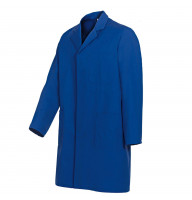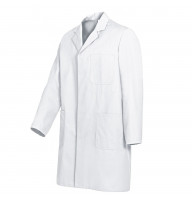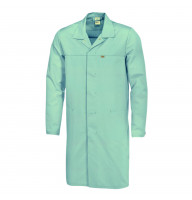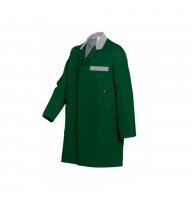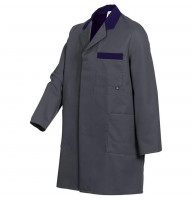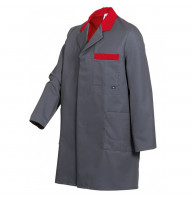0.00€
CheckoutWorking Gowns — A Necessity or an Outdated Element of Workwear?

The gown as a component of professional attire first appeared in the 19th century. Initially, it was used in medical institutions and laboratories, and later in industrial and service sectors. Its primary function was to protect the body and clothing from dust, dirt, chemicals, and microorganisms.
Is the Gown Still Relevant Today?
Despite the growing popularity of overalls and modern workwear, working gowns remain in demand in many industries. They have not lost their relevance; on the contrary, they have evolved to become more ergonomic, functional, and stylish.Main Functions of a Modern Working Gown:
-
Protection from External Factors: dust, moisture, chemicals, and contaminants.
-
Hygiene: especially important in medicine, the food industry, and laboratories.
-
Professional Appearance: the gown helps create a visual image of a specialist, adding neatness and authority.
Where Are Working Gowns Used?
-
Medicine and Care
-
Doctors and Nurses: classic white gowns or modern models with elastic inserts.
-
Palliative Care: comfort and a delicate appearance that facilitate positive interaction with patients.
-
Veterinarians: gowns made from water- and stain-resistant fabrics, convenient for active work with animals.
-
-
Engineering and Technical Professions
Electricians, mechanics, and design engineers use durable gowns with anti-static and fire-resistant properties. -
Chemical Industry and Laboratories
Laboratory technicians, chemists, and researchers choose gowns made from acid-resistant fabrics with closed cuffs and long sleeves. -
HORECA and Service Industry
Chefs, waiters, housekeepers, and laundry workers opt for models made from lightweight, breathable fabrics that are easy to wash. -
Warehouse and Production Specialists
Loaders, logistics personnel, and quality controllers use gowns made of robust fabrics with pockets for tools. -
Carpenters, Joiners, and Repairmen
Comfortable models with reinforced areas on the elbows, sturdy seams, and a loose cut.
Features of Working Gowns for Different Professions
Materials:
-
Cotton — natural, pleasant against the skin, but less resistant to wear.
-
Polyester — durable and withstands multiple washings well.
-
Blended Fabrics — offer an ideal balance of comfort and durability.
-
Special Fabrics: fire-resistant, acid-resistant, and anti-static.
Fit and Comfort:
-
Loose Cut — ensures freedom of movement.
-
Belt or Drawstring — allows for adjustable fit.
-
Ventilation Openings — provide air circulation.
Additional Elements:
-
Pockets — for tools, notebooks, or phones.
-
Fastenings — buttons, zippers, or hook-and-loop closures.
-
Cuffs — elastic, with buttons or closed.
Length and Sleeves:
-
Length: can be knee-length, below the knee, or extended.
-
Sleeves: available in short or long lengths, with the option to roll them up.
Working Gowns for Specific Professions
Electricians:
-
Non-flammable materials, anti-static properties, and reinforced seams for safety.
-
Closed cuffs, convenient pockets, and durable fastenings.
Laboratory Technicians/Chemists:
-
Acid-resistant fabrics, long sleeves, and a protective cut.
-
Ventilation in the back area and a collar to protect the neck.
Engineers/Scientists:
-
Discreet design, universal length, tool pockets, and easy maintenance.
Warehouse Workers:
-
Durability, ergonomic design, and freedom of movement without restrictions.
-
High resistance to contaminants, with reinforced areas in high-friction zones.
Carpenters/Joiners:
-
Dense, wear-resistant materials, protective elbow patches, and pockets with closures.
Modern Trends: Hybrid Models and Personalization
-
Combination of Gown and Jacket: offers comfort and additional protection.
-
Elastic Inserts: provide extra comfort and minimize movement restriction.
-
Branding Options: logos, names, and colorful designs in line with corporate style.
Why Gowns Have Not Lost Their Relevance
-
Functionality: gowns complement workwear and reduce overall wear and tear.
-
Cost-Effectiveness: easy to care for and more affordable compared to overalls or jackets.
-
Adaptability: a wide range of materials, cuts, and configurations allows for an optimal choice for any industry.
How to Choose a Working Gown: Tips for Buyers
-
By Size: refer to size charts and consider the use of undergarments.
-
By Season: choose lightweight fabrics for summer and insulated or combinable options for winter.
-
By Purpose: pay attention to the safety requirements of your profession.
-
By Type of Fastening: select those that are easy to put on and remove, especially in emergency situations.
A working gown is not a relic, but a proven tool for safety, hygiene, and professional appearance. It remains relevant across many sectors, adapting to modern requirements and technologies. Thanks to the variety of models, materials, and functions, every specialist can find the ideal option.
Choose professional gowns from our online store:
Browse our catalog of gowns and other workwear to find the perfect solution for your work.



